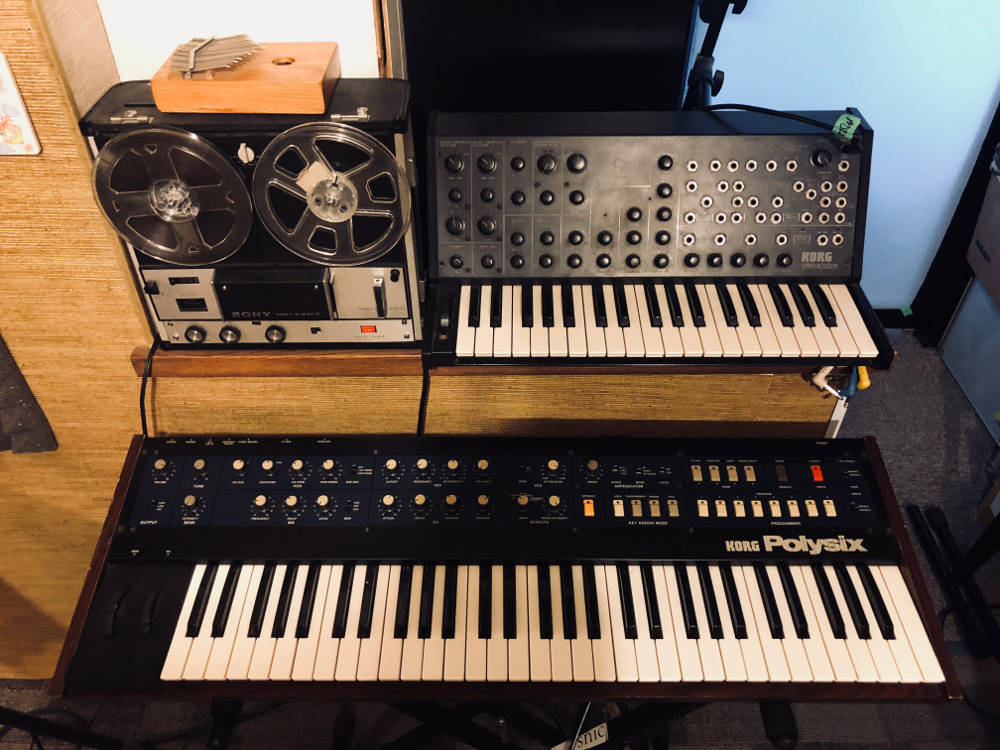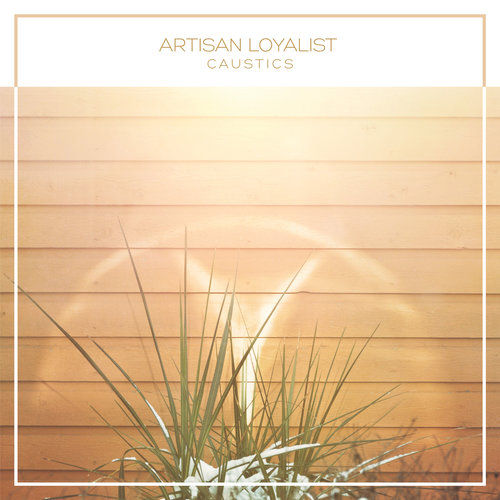The Synth Expert’s Signal Paths: How to Get Stellar Sounds with Analog or Virtual Instruments
Plug ‘n’ play? No way!
Rob Batke, a.k.a. The musical adventurer Artisan Loyalist, is not one to dial up a preset on his synthesizers — analog, digital or plugin — and run with it. Instead, his principle of very carefully crafting a synth sound and signal path is firmly reflected in his new album, Caustics (Sky Council Recordings). Lush, immersive, advanced and retro all at once, it’s an adventurous record that was sculpted with precision, while still leaving room for happy accidents.
A producer and composer recording out of his personal space in Edmonton, Alberta, Batke’s official bio refers to him as an instrumentalist. But once you hear the record and read what follows you’ll know the truth — vintage synths simply must be his truest love. His studio is stacked with them, and he’s gotten to know each sound source intimately.
Want a boatload of new ideas on how to improve your own synth techniques? Whether you have some vintage hardware synths of your own, or you’re working strictly in the box (ITB) with virtual instruments, read on. Batke’s breakdown below of five of Caustic’s nine tracks are absolutely indispensable, as he explains how he selected each song’s instruments, lays out the signal path, and then offers up a strictly ITB alternative route — often incorporating free instruments and effects. Like a sonic sommelier, he’ll tell you which virtual synths pair well with which plugins to emulate the classic sounds he’s achieved.
Along the way you’ll learn not just how he recorded synths, but also get an academic earful on each keyboard’s unique characteristics. As you delve into the songwriting process of a synthesizer master, a whole new way to think about and listen to synths is revealed: The intricate interplay between effects and pedals and their optimal matches with different synths are deeply explored. Plus, discover how the right processing can take even the cheesiest of synth sounds to artistic heights.
Following the song synopses, the man behind Artisan Loyalist caps it off with music production wisdom that you’ll want to apply to your next song. So dig in even if you’re no synth head because — like we said — Batke really is a multi-instrumentalist, with guitars and vocals aplenty on Caustics, offering up plenty of studio best practices no matter what you play.
“OXIDITE”
Synth Inspiration: “Oxidite” began very humbly. It was demoed with a very simple drum beat, and I chorded through the song on my Korg Polysix using a simple brass patch.
A semi-open filter brass sound on the Polysix can sound rather wooly, and also the tuning is rather interesting. After having my Polysix repaired, my tech, John Leimseider (of National Music Centre fame in Calgary, Alberta) told me that the scaling is tuned such that the lower octaves are slightly flat, and the higher octaves are just a bit sharp.
These characteristics of the Polysix led me to utilize it more in writing various songs for Caustics. Previously, I would typically go straight to my Juno 106, which yields a beautiful tone, but its DCO oscillators are just that much more stable than the VCO oscillators of the Polysix. The Polysix just has this raw natural tone that seems to evoke different parts than than the Juno. I still utilize the Juno lots in my productions, but the introduction of my Polysix on Caustics allowed for some new timbres to come through.
Signal Path: The other synth part of the song is a string patch on the Polysix running through an Ursa Major SST-282 Space Station. It is a very early digital delay/reverb that is quite low resolution (12-bit, I believe), and achieves its reverb sound by smearing the sound with 4 multi-tap delays. It has a dark, grainy quality like no other vintage effect I have heard, and its lushness is in how crude the sound is. This, paired with the string patch, helped to create somewhat of a “bowing” sound, because of all the multi-tap delays, subtle modulations, and pitch instability.
This sound, along with the rest of the album, was recorded into Ableton Live using Focusrite ISA preamps, and Apogee or Presonus interfaces.
Finally, the Polysix string patch was reversed in Ableton Live for the intro section, and then plays forwards again once the drums and other instruments come in.
Doing It ITB: Korg’s Polysix legacy plugin would be a solid choice, but I would almost sooner recommend the Repro-5 plugin by U-He and using only one oscillator in the mixer. It is a Prophet 5 emulation, and not Korg, but U-He has made some of the most authentic analog emulations of vintage synthesizers to date. Either the Korg or U-He plugin through a vintage-style delay like Soundtoys’ Primal Tap would be great together.
“REFRACTOR”
Synth Inspiration: “Refractor,” like “Oxidite,” began quite simply with the drum beat and some brass chords on the Korg Polysix. Doubling the brass chords is a piano sound on the Ensoniq SQ-80 (I will tend to that description a little later when breaking down the process for the song “Lie Awake,” as it features the same sound but more prominently).
Listening back to the early, crude demos of “Refractor” and “Oxidite” are quite funny, really, as they are very dry sounding, and lack the hugeness that developed over time. However, there are small hints of the song emerging very early on, and I tried to follow my nose with these ones.
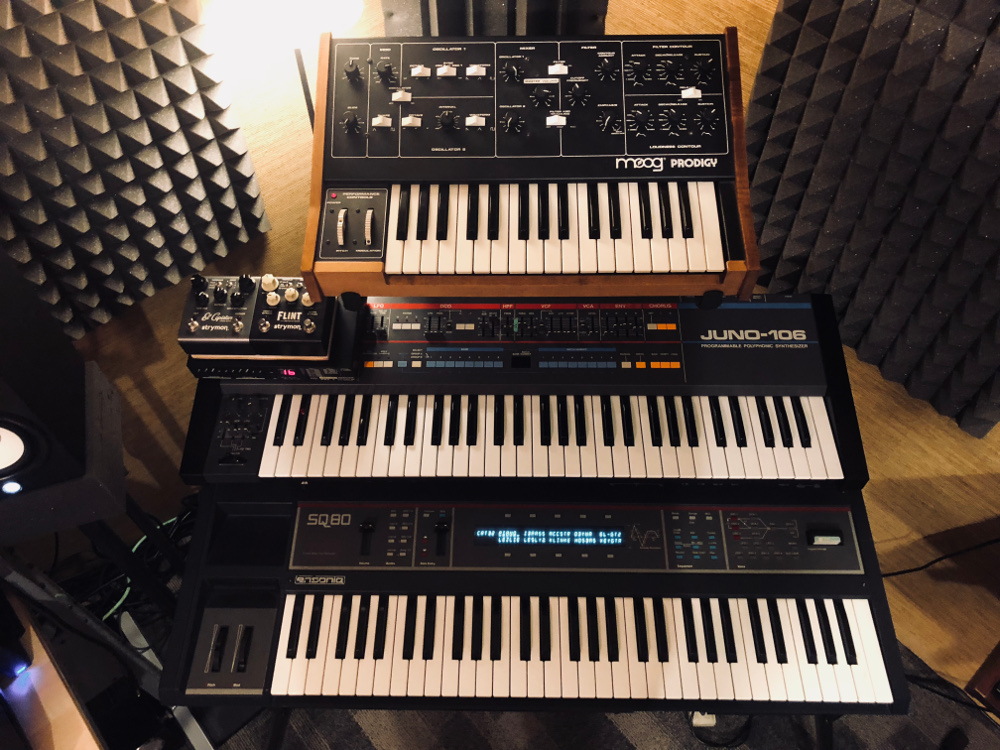
Batke’s Moog Prodigy Analog Mono Synth (above); Roland Juno 106 Analog Poly Synth (middle); Strymon El Capistan Tape Delay Emulation and Strymon Flint Tremolo and Digital Reverb (middle left); Ensoniq SQ-80 Hybrid Synthesizer (below)
Specifically, the synth solo near the end of the song is played on the Moog Prodigy, and I really had not recorded it all that well. It was tracked somewhat rushed, and was mostly improvised in real time, but that take became what I used in the final mix of the song. It just had the right feeling, and even if I had to carefully edit out a click or popping artefact that snuck its way in, it was worth it as I often find it extremely hard to replicate the feeling of how certain parts are played, especially when they happen while the song is germinating. It was a good reminder to record things as best as I can—even if I think it is just a demo idea—as it may very well be an integral part of the song.
Signal Path: At the time, my Moog Prodigy needed some repairs and only one oscillator worked. This was a welcome restraint, as the one oscillator lead sound proved to have more of a sweet tone, whereas mixing in a second oscillator, although more harmonically rich, can end up being more brash when it might not be necessary.
I ran the Prodigy through my Strymon El Capistan tape delay emulation, and the Prodigy really takes well to the El Capistan. Although predominantly guitar-based effects, Strymon pedals take line level instruments, so they pair very well with synthesizers. The tape effect gives a nice wash to the lead sound, but it does not drown out the tone where a heavy reverb effect might have done so.
Doing It ITB: Although it is not modelled after a Moog, but rather the Sequential Pro One, U-He’s Repro-1 plugin (with only one oscillator engaged) through Soundtoys’ EchoBoy would be a nice pairing.
“ACRES”
Synth Inspiration: “Acres” began while at a rehearsal as I played the staccato organ-type riff, and quickly captured it as a voice memo so that I would not forget it. The rest of the song was written all around that riff, although it does not sit at the front of the mix. The other signature part would be the lead “ahhhh” patch at the very beginning of the song: that is an 8-bit vocal sample from the SQ-80 going through some 80s-style hall reverb.
Signal Path: In the chorus, there is a brass patch from my Korg DW-6000, which is a mid-80s hybrid synth that has low resolution sample oscillators and analog filters (similar to the SQ-80).
I experimented with that brass patch by having one of the oscillators tuned an octave lower than the other, which on an analog synth would typically produce a larger sound.
However, I found that if I had both oscillator one and two set to the same footage (tuned to the same octave), it would produce some brash aliasing on the top end of the sound as the two digital oscillators fought for the same sonic space. It is a very subtle effect on the finished recording, but that little bit of digital edge helps give some bite in a way that synths with solely analog audio paths typically do not.
Doing It ITB: Although I have not had a chance to use it yet, I have heard amazing things about the SQ-80 plugin, SQ8L. An instance of SQ8L with some of the sampled waveforms, through some Valhalla Vintage Verb should yield good results for either synth sound. The best part about the SQ8L plugin is that it is free!
“LIE AWAKE”
Synth Inspiration: “Lie Awake” was mostly improvised and recorded in real time. It is a similar approach to how I wrote lots of my first EP, You’re Glory. This piano sound is one of the more signature sounds I have worked on post-Lonely Ghost. It is a really cheap sounding 8-bit piano sample from the Ensoniq SQ-80.
Really, it is such a bad sound on its own; quite laughable. But, with the right processing, it has tons of character — the low bit resolution gives it some nice bite, too, and fits well within the ‘80s piano sound I was after. I have a Yamaha CP-70B electric piano at home—notable for the Peter Gabriel and U2 piano sound of the ‘80s — and although I wanted to record it for Caustics, I did not have it accessible at the studio and needed to get sounds quicker in order to meet my recording deadline, so I utilized the SQ-80 with some more non-conventional processing.
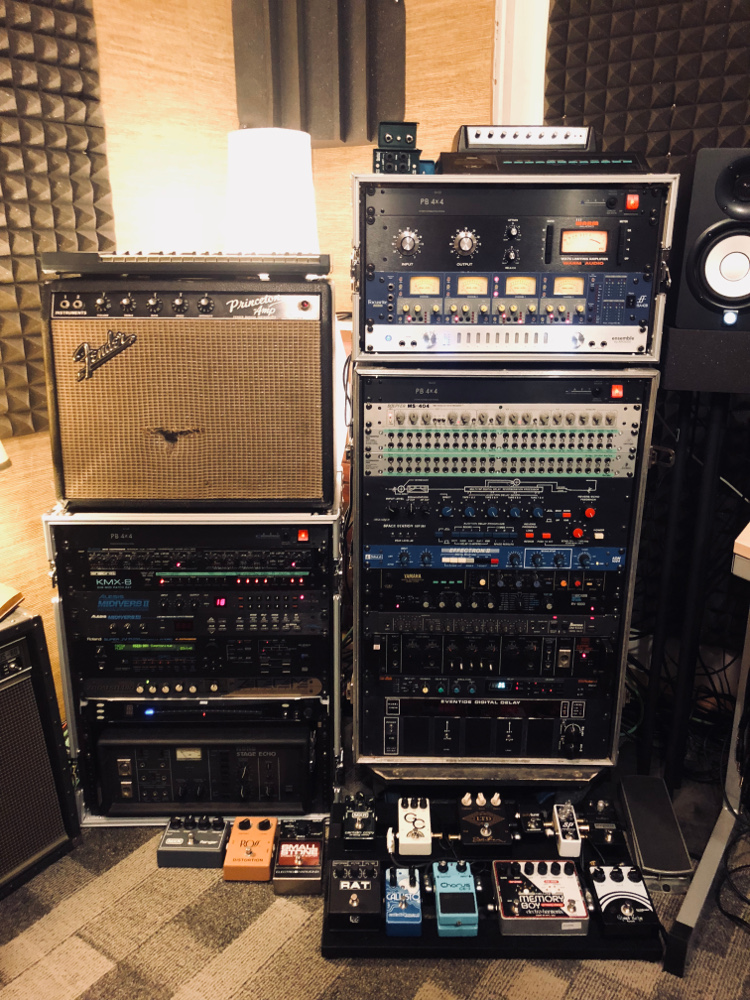
Racks; 1966 Fender Princeton Guitar Amplifier; Miscellaneous guitar pedals; Simmons Clap Trap & Yamaha TX7 Synthesizer sitting on top of large rack; in the top rack are the Warm Audio WA76 Compressor, Focusrite ISA 428, and Apogee Ensemble
Signal Path: The SQ-80 is going straight into the Strymon El Capistan tape delay emulation, and then getting compressed through the Warm Audio WA76, an 1176-style hardware compressor. Some engineers might put the delay after the compression, but what it does in this instance is allow for the delays to be embedded with the original sound, further saturating them both together.
Then, the signal path goes into Ableton Live where it undergoes some major high passed low end EQ removal to get rid of lots of the accumulated mud, and then finally through the Valhalla Vintage Verb plugin for some chorused, hall reverb.
Doing It ITB: Again, the SQ-8L plugin would be a great choice, but even a stock MIDI piano sound from any major DAW could contend. Most of those piano sounds are not amazing to begin with, but all the more reason to try and change them up in order to get a better result. One could use the DAW’s piano sound into a delay like Soundtoys’ EchoBoy, followed by a FET-style compressor plugin, then into a high-pass filter and finally into Valhalla Vintage Verb.
“FOUND HERE BELOW”
Synth Inspiration: “Found Here Below” began with an organ sound on the SQ-80, going through the Valhalla Vintage Verb plugin. Also, there is a fair amount of Roland Juno 106 on the song, both in the higher, silky synth pads, and the acid synth bass at the climax of the track.
The organ sound is pretty standard, and worked well as the sharp transient attacks poke out through the reverb at the front of each note change, specifically as there is a part where the organ pad plays two motifs of three ascending notes—the transients, with the reverb, begin to sound like drum machine claps.
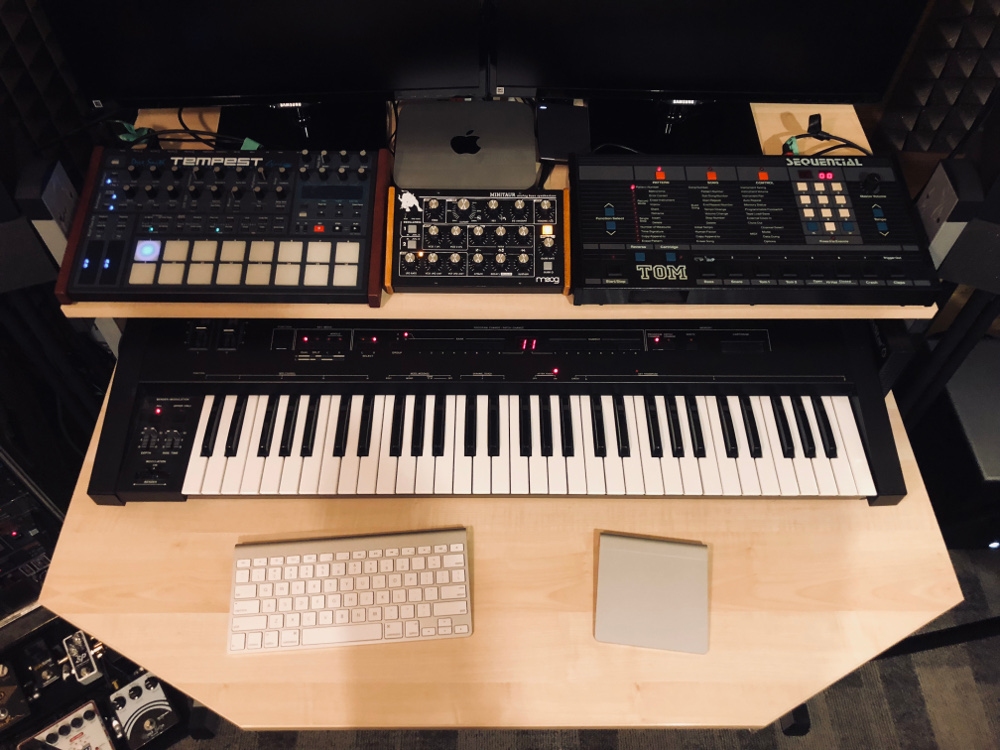
More succulent sound sources: Dave Smith Instruments Tempest Analog Drum Machine/Synthesizer(above left); Moog Minitaur Analog Mono Synth (above centre); Sequential TOM Drum Machine (above right); Roland MKB-200 Midi Keyboard (lower)
Each chord for the regular organ pad was played out in long stretches, and then I chopped off the beginning transient, resulting in the chords switching immediately. This removed more of the human element in how it would have sounded had it been played normally. And, each chopped chord section had its own sense of the audio ‘beating’, or subtle pulsation.
Signal Path: Although the silky synth pad on the Juno 106 is not the most prominent synth part in this song, it is one of the most important sounds in my work. It is the primary pad sound for every track on the You’re Glory EP, and makes appearances on Lonely Ghost, too. The oscillators are set to sawtooth waves, and the attack-decay-sustain-release parameters on the envelope are all brought up to varying degrees. Part of what makes the sound more alive is a very subtle pitch modulation via a slow moving LFO on the oscillators.
The filter is somewhat closed, and is beautiful to adjust and play with, especially through a lush reverb. I always have the Juno plugged directly into my Strymon Flint, with the “‘80s reverb” engaged. This reverb sound models some of the vintage Lexicon units, and is really amazing. In some ways, this might be one of my most signature synth sounds, and it is something that I can readily replicate in a live situation, too.
One fun trick with the Flint is to play a chord, and then max out the decay setting for some long, lush reverb tails. They make for great textures and can help glue certain parts of a mix together, even if only one note is played, and you can even reverse the reverb tail for a slow pad sound that does not take over a mix, and it will increase in its intensity as it progresses.
Doing It ITB: Togu Audio Line, or TAL, makes some of the best plugin synths for the price. I use their Bassline 101 plugin extensively, which emulates the Roland SH-101, and it is such a great instrument. I think producers sometimes think that they need to spend more money to get better sounds, and that really is not true: The paid TAL plugins are all of $50, and their Juno-60 emulation, U-NO 62 — although a bit old now—is free just like SQ-8L! U-NO 62 through Valhalla Vintage Verb would make for a great Juno-style pad sound.
The Big Picture:
Here are the Big Lessons I learned from recording Caustics:
Simplify — write the one specific part and stick with it rather than layering more iterations or possibilities on what you already have.
Force your hand and commit to printing audio in your DAW. There are too many options these days, and we need to get better at knowing what the sound is, achieving it (or as best as one can), and then committing to and living with it. If we do not really have to live with our engineering choices, we do not improve to the same degree or speed as we could have—endless options stop one from ever having to “own” a mistake.
The same goes for actually releasing the music: You have to get it out there and own it, good and bad. That is the only way to grow—by finishing things. Too many technological options leave too many opportunities to “fix” something after the fact, or just change what already works. This is also why I moved away from recording MIDI and audio parts at the same time, to just recording the audio take right then and there. Same with guitar parts and vocal parts, as I often double and quadruple tracked them, and the repetition ensures that the part is “right” and finds a way to sit in the song along with adding some natural chorusing.
Perform melodies and riffs, and fit the vocals around them in the gaps. If one theme or motif emerges early on, roll with it, and write the rest of the parts in the spaces where that first part does not play out. That constraint will help keep the song focused, and eliminates all the possible parts that “could” be played, but are not necessarily needed for the song.
Use what you have got: After Lonely Ghost was released, my Polysix got repaired and was now studio ready, but my Yamaha CS-60 was then out of commission, along with a few other vintage monosynths I have. Do not wait for more gear in order to start—use what is in front of you. Having certain synths out of the picture was advantageous as it takes away the temptation to utilize absolutely every bit of gear in the studio. It is nice to have the options, but once you pare down and hone your sonic palette for a project, try and stick within those boundaries.
Reamp synths! Avoid just playing them directly into your interface—run them through a mic’d guitar amp, and blend the amp signal with the original. It does not need to be a drastic effect, but a parallel amp mix will give a slight edge to your synth sounds, especially percussive or punchy bass synth sounds, and will allow them to rise up in the mix and not get drowned out by the rest of the tracks or layers.
Avoid buying every plugin available. You will end up with a bunch of software you will never use, and even if they are a deal or are on sale, you will still be behind cash-wise. Get a select few plugins and learn them well, or learn how you yourself use them well.
Get free plugins: OBXd, Dexed, U-NO 60, SQ-8L, TAL Chorus. There is plenty of great stuff out there that is up for grabs.
Record a demo idea as if it were a final take; you may very well utilize it in the mix.
— David Weiss
Please note: When you buy products through links on this page, we may earn an affiliate commission.








